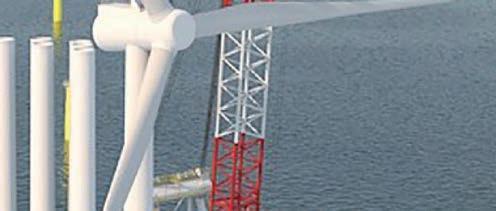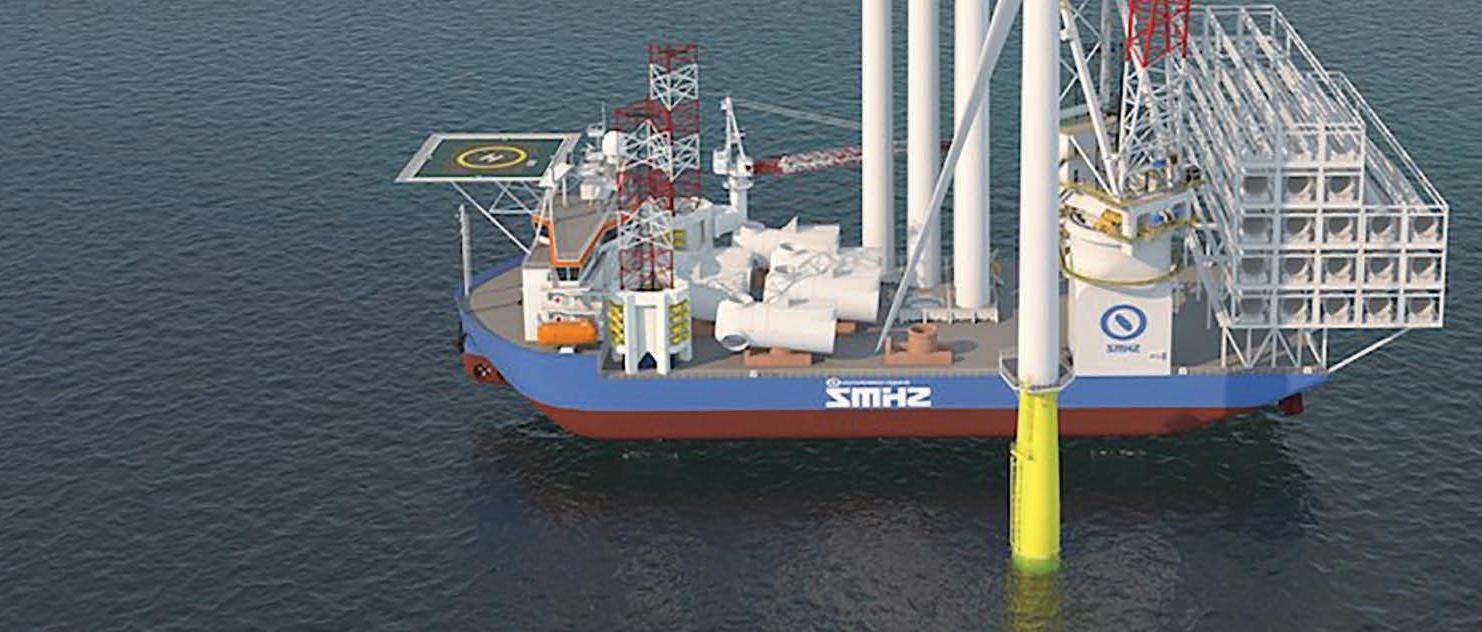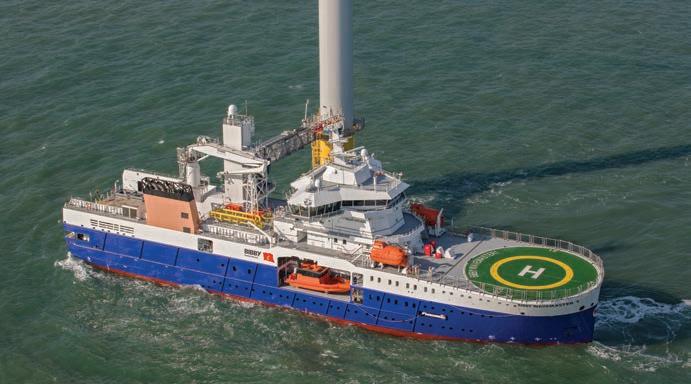
12 minute read
OFFSHORE OPPORTUNITIES: OSVs, Wind and More: Hope is in the Wind
by Marine Log
OFFSHORE: HOPE IS IN THE WIND

Advertisement




By Nick Blenkey, Web Editor

As controversy continues over Jones Act requirements for U.S. offshore wind farm development, ABB is supplying advanced power systems for a giant Japanese wind turbine installation vessel that will have a 2,500-ton crane capable of a maximum lift height of 518 feet.

The future of U.S. offshore services and offshore service vessel construction clearly lies in the offshore wind sector. In its just published, members-only U.S. Offshore Wind Market Report & Insights 2020, the Business Network for Offshore Wind notes that the 2020s, “are sure to be a booming decade for American offshore wind,” and paints a picture of an industry currently constrained only by the necessary length of various permitting processes.
The Business Network report say that, in the next four to six years, U.S. developers expect to manufacture, construct and install over 9,000 megawatts of offshore wind. That, of course, is a fraction of the offshore wind power generated in European countries that have been committed to offshore wind for decades, with the U.K.’s massive Hornsea Wind Farm alone expected to have a total capacity of over 6,000 megawatts. But it’s still a massive advance for a U.S. industry whose first operational offshore wind farm, Block Island, started operation just three years ago off of Rhode Island.
All this is in stark contrast to the traditional offshore oil and gas sector, where the going looks as though its can only get tougher. sector has been hit with the double whammy of the coronavirus outbreak going worldwide and Saudi Arabia disrupting the oil market and sending oil prices plunging. The world is now so awash with petroleum that more and more production is going straight into storage. In the U.S., the Trump administration announced last month that it would purchase 77 million barrels of American-produced crude oil and fill the salt caverns of the National Strategic Petroleum Reserve to capacity.
“The Department of Energy is moving quickly to support U.S. oil producers facing potentially catastrophic losses from the impacts of COVID-19 and the intentional disruption to world oil markets by foreign
actors,” said U.S. Energy Sec. Dan Brouillette.
Not everyone has salt caverns in which to store petroleum. Internationally, commodity tracking specialist Kpler reported 110 million barrels of oil as being in storage afloat at the end of March.
Given all that, not too surprisingly, bidding on federal oil and gas leases in the Gulf of Mexico on March 8, the very day Saudi Arabia announced its oil price cuts, was the lowest since Gulf-wide sales began in August 2017—and lower than any sale since 1993 for the central Gulf, with 22 companies making $93 million in high bids on 71 tracts.
Add to that news from oil majors that they are cutting capital expenditures as a result of market conditions caused by the COVID-19 pandemic and commodity price decreases, the outlook for offshore oil and gas is challenging to say the least.
Though the year thus far has produced a couple of orders for new jack-up rigs, mostly the international news has been about restructurings, with France’s Bourbon Offshore now belonging to the banks.
The overarching problem for the offshore services sector is that there are too many vessels out there and too many players. As noted by Quintin Kneen, president and CEO of Tidewater, in a call with financial analysts on March 4, “the industry is highly fragmented. There are nearly 600 participants and only four, including Tidewater, have more than 2.5% of the market.”
“The industry has lethal levels of debt that is preventing consolidation, because many capital holders are looking for power returns,” Kneen continued. “Power returns are not going to happen. The cavalry isn’t coming. The market is not going to save those capital providers.”
Kneen sees the industry’s problems as including the day-rate business model and sees a future that will “see the industry eventually gravitate to regional super consolidators, who will be able to leverage a scalable shore-based footprint to operate the most vessels possible at the lowest cost possible in a particular region.”
Meantime, Kneen indicated that his focus right now is on improving Tidewater’s free cash flow through four categories: increased cash flow from reduced G&A, increased cash flow from vessel disposals, increased cash flow from reduced investments in vessels, and increased cash flow from core vessel operations.
Switch to Renewables Among the survivors in the U.S. industry will be those able to make the transition from the oil patch to offshore wind. Last June, the Offshore Marine Service Association (OMSA) formed the OMSA Wind Committee. Among its priorities will be to work to ensure that U.S. offshore wind activities are carried out in compliance with the Jones Act.
“The U.S. maritime industry has met the needs of every market it has encountered, and I’m confident that the offshore wind market will be no different,” said Court Ramsay, chairman of the OMSA Board of Directors and president of Aries Marine. “I know my company has already committed vessels, resources, and personnel to offshore wind, and I look forward to working with fellow OMSA members on the OMSA Wind Committee to promote this market.”
Lee Orgeron, OMSA board member and CEO of Falcon Global said, “Our company helped construct the Block Island Wind Farm, and we look forward to sharing the expertise we gained in completing this first commercial wind farm in the U.S. with our fellow OMSA members on the committee.”
Falcon Global last month became a wholly owned subsidiary of SEACOR Marine, which bought out the 28% minority stake previously held by Montco Offshore. Commenting on the acquisition, SEACOR said that it gave it control of 14 liftboats with vessels currently working in the U.S. Gulf of Mexico, Mexico, and Saudi Arabia and noted that “liftboats provide a selfpropelled, stable platform to perform support for wind farm installation and maintenance” among other things.
Maintaining Momentum Given the impact on the global economy of the coronavirus outbreak, there are no guarantees that the path ahead for any sector will be easy. The Business Network for Offshore Wind says its main concern here centers around the economic hardship a long-term shutdown and recession would place on secondary and tertiary U.S. suppliers. It point outs that there is almost 10 GW of U.S. offshore wind development being supported with public sector financial mechanisms that will be a boost for local economies.
“If the White House wants to boost the economy, it doesn’t have to look any further than the Department of Interior, which has the authority to approve massive infrastructure offshore wind energy projects and currently has four under review,” says the association.
The study not only gives a comprehensive rundown on the status of current U.S. projects, but also sheds some useful light onto the vessels that will be needed to install and maintain the growing number of U.S. offshore wind farms.
Jones Act One of the most contentious issues facing the industry relates to installation vessels and the Jones Act—or, more specifically, how Customs and Border Protection interprets what non-Jones-Act-qualified installation vessels can and cannot do. Without trying to open that particular can of worms here, it is fair to say that there are currently no Jones Act installation vessels in any way comparable to those currently entering the world market, or on order, to meet the need of next-generation wind farms with their everlarger turbines.
The Business Network study notes that, in response to a mandate in the National Defense Authorization Act of 2020 (NDAA) the Government Accountability Office (GAO) is conducting work regarding Jones Act-compliant vessels required to support offshore wind
Ulstein is currently completing the advanced Wind Service Operation
Vessel Windea Jules Verne for Bernhard Schulte Offshore, which has partnered with MidOcean Wind to provide similar, Jones Act-compliant, vessels to the U.S. market.

Resolve Marine Group has signed an MoU with U.K.’s Bibby Marine
Services to bring Jones Actcompliant “Walk to Work” vessels like this to the U.S. Market.

energy projects. Preliminary findings will be reported to Congress in June.
Specifically, NDAA requires GAO to provide to Congress an inventory of vessels to install, operate, and maintain emerging offshore energy infrastructure; a projection of existing vessels needed to meet such emerging offshore energy needs over the next 10 years; a summary of actions taken or proposed by offshore energy developers and producers, the U.S. domestic shipbuilding industry, and U.S. coastwise qualified operators to ensure sufficient vessel capacity in compliance with laws; and a description of potential benefits to the U.S. maritime and shipbuilding industries and U.S. economy associated with the use of qualified vessels to support offshore energy development.
“This increased focus upon the vessel needs of U.S. offshore wind projects signals that Congress is awakening to the industry’s significant economic development prospects, and that federal resources are beginning to be mobilized to meet that demand,” says the study. “The U.S. offshore wind industry needs appropriate port infrastructure and vessels, in both the short and longer term. The maturation of domestic U.S. offshore wind vessel, maritime, and port industries will provide jobs for Americans and will aid in continuing to drive down U.S. offshore wind project costs.”
“We believe 2020 will be the year of the offshore wind vessel,” says the study. “Additional crew transfer vessels (CTVs) and service operation vessels (SOVs) orders will follow during 2020-21 as projects in New York, New Jersey, and Virginia advance through the development and permitting processes. Forecasts suggest 50 to 60 CTVs and four to eight SOVs must be built in the next five to six years to service the projected offshore wind pipeline.”
Regarding vessels, the study notes that in 2019, two different Rhode Island shipyards received orders for the construction of three CTVs. These include Ørsted hired Senesco Marine, which is to build a CTV in its North Kingstown, R.I., shipyard, and Atlantic Wind Transfers, which placed an order for two Chartwell 24 CTVs built locally at Blount Boats in Warren, R.I., with delivery expected in 2020 and 2021.
Partnerships Form Several leading U.S. companies have already formed partnerships aimed at bringing lessons learned from European offshore wind industry experience.
In July last year, Resolve Marine Group Inc. reported that it had signed a Memorandum of Understanding (MoU) with Bibby Marine Services, a U.K.-based “Walk to Work” (W2W) vessel specialist operating primarily in the European offshore wind sector.
The MoU will see the two companies proactively develop Jones Act-compliant vessel solutions for the emerging and exciting U.S. offshore wind sector. Resolve’s nearly four decades of experience as a Jones Act operator, together with Bibby’s already established U.K. and European services in the same target sector, provide a platform that will look to provide wind farm operators and wind turbine suppliers effective Jones Act compliant W2W vessel solutions.
Resolve and Bibby will leverage their customer service led approach to partner with wind resource providers to deliver timely and innovative services in this forwardlooking sector.
While the initial focus will be on W2W vessel solutions, the partners are targeting a wider range of multi-faceted solutions, including CTV requirements, safety training, emergency response, and firefighting standby services as well as logistical support utilizing their established experience in the most challenging aspects of the maritime sector.
Bernhard Schulte Offshore GmbH (BSO) and MidOcean Wind LLC (MOW) have entered into a joint venture to build and operate support vessels for the U.S. offshore wind industry as well as to explore opportunities in other sectors of U.S. merchant shipping.
The Connecticut-based joint venture marks another step forward in a cooperation between BSO and MOW hat began in late 2018 when the two parties partnered in WINDEA Offshore U.S. to provide a single point of contact for offshore wind customers in the U.S.
“We have been following the successes of the Schulte Group for some time now and recognize they share the same business values and focus on long-term partnerships,” said Volckert van Reesema, co-founder and principal of MOW.
“The Schulte Group has a track record of more than 550 new-building projects around the globe and MidOcean is a specialist at building vessels of various types under the local regulations in several U.S. shipyards,” said Matthias Müller, managing director of BSO. “Since the on-time delivery of a vessel to our charterers is critical, we are the ideal partners to support the U.S. offshore wind industry with specialized units.”
“Wind farm owners and turbine manufacturers will be able to reduce their risks by working with our team,” said Bradley Neuberth of MOW. “MidOcean will ensure the vessels will be Jones Act-compliant and delivered as agreed. Bernhard Schulte Shipmanagement, as the operator of the ships, will bring the learnings of the European wind farm projects into the U.S. market. We have been working closely with the Schulte Group for more than a year and the time is right to formalize our partnership on offshore wind vessels.”
MOW is a subsidiary of MidOcean Marine, a privately owned company specializing in niche U.S.-flag maritime projects that builds and positions assets for underserved and unmet market needs.
Foss Maritime LLC, Seattle, has signed an MoU with Haugesund, Norway-headquartered Østensjø Rederi AS to establish a partnership to provide domestic SOVs for offshore wind projects in U.S. waters.
“After spending time in Europe engaging with marine service providers, we are very fortunate to have developed this relationship with the experienced team at Østensjø,” said Paul Gallagher, vice president at Foss Maritime said. “We look forward to bringing the collective resources of our two companies together to develop safe and cost competitive marine solutions for the offshore renewables market in the United States.”
One Magazine, The Entire Market




SIGN UP: http://bit.ly/mlnewsletter
Never Read YESTERDAY’S NEWS







Marine Daily delivers marine news as it unfolds. Sent every weekday, this email newsletter delivers today’s news today. Stay up-todate on the entire market, from shipyards and salvage to tankers, towboats and alternative energy.




